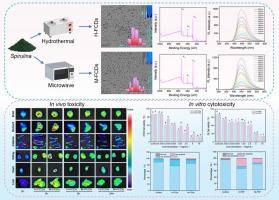Carbon dots from thermally processed Spirulina: Properties, biodistribution and cytotoxicity
IF 9.8
1区 农林科学
Q1 CHEMISTRY, APPLIED
引用次数: 0
Abstract
Foodborne carbon dots (FCDs) are ubiquitous nanoparticles in thermally processed foods that have received attention for potential health risks. Herein, FCDs were extracted from Spirulina by hydrothermal (H-FCDs) and microwave (M-FCDs) methods, and their properties, biodistribution, and biotoxicity were explored. The results showed that H-FCDs had higher nitrogen content, quantum yield, fluorescence stability, and smaller molecular weight than M-FCDs. In vivo experiments indicated that FCDs could distribute in intestine, kidney, liver, and brain of mice, but caused no obvious acute toxicity at 2 g/kg. In vitro studies showed that FCDs were internalized by HT29 and C6 cells, inducing oxidative stress, disrupting Ca2+ homeostasis, and mitochondrial membrane potential. Besides, compared with M-FCDs, H-FCDs significantly upregulated Bax, downregulated Bcl-2, promoted the release of Cyt-C, and activated Caspase-3, thereby inducing apoptosis in HT29 cells. These findings provide insights for the potential health risks of FCDs in thermally processed Spirulina foods.

热处理螺旋藻的碳点:性质、生物分布和细胞毒性
食源性碳点(FCDs)是热加工食品中普遍存在的纳米颗粒,因其潜在的健康风险而受到关注。本文采用水热法(H-FCDs)和微波法(M-FCDs)从螺旋藻中提取FCDs,并对其性质、生物分布和生物毒性进行了研究。结果表明,H-FCDs比M-FCDs具有更高的氮含量、量子产率、荧光稳定性和更小的分子量。体内实验表明,FCDs可分布于小鼠肠、肾、肝和脑,但在2 g/kg剂量下无明显急性毒性。体外研究表明,FCDs可被HT29和C6细胞内化,诱导氧化应激,破坏Ca2+稳态和线粒体膜电位。此外,与M-FCDs相比,H-FCDs显著上调Bax,下调Bcl-2,促进Cyt-C的释放,激活Caspase-3,从而诱导HT29细胞凋亡。这些发现为热加工螺旋藻食品中FCDs的潜在健康风险提供了见解。
本文章由计算机程序翻译,如有差异,请以英文原文为准。
求助全文
约1分钟内获得全文
求助全文
来源期刊

Food Chemistry
工程技术-食品科技
CiteScore
16.30
自引率
10.20%
发文量
3130
审稿时长
122 days
期刊介绍:
Food Chemistry publishes original research papers dealing with the advancement of the chemistry and biochemistry of foods or the analytical methods/ approach used. All papers should focus on the novelty of the research carried out.
 求助内容:
求助内容: 应助结果提醒方式:
应助结果提醒方式:


